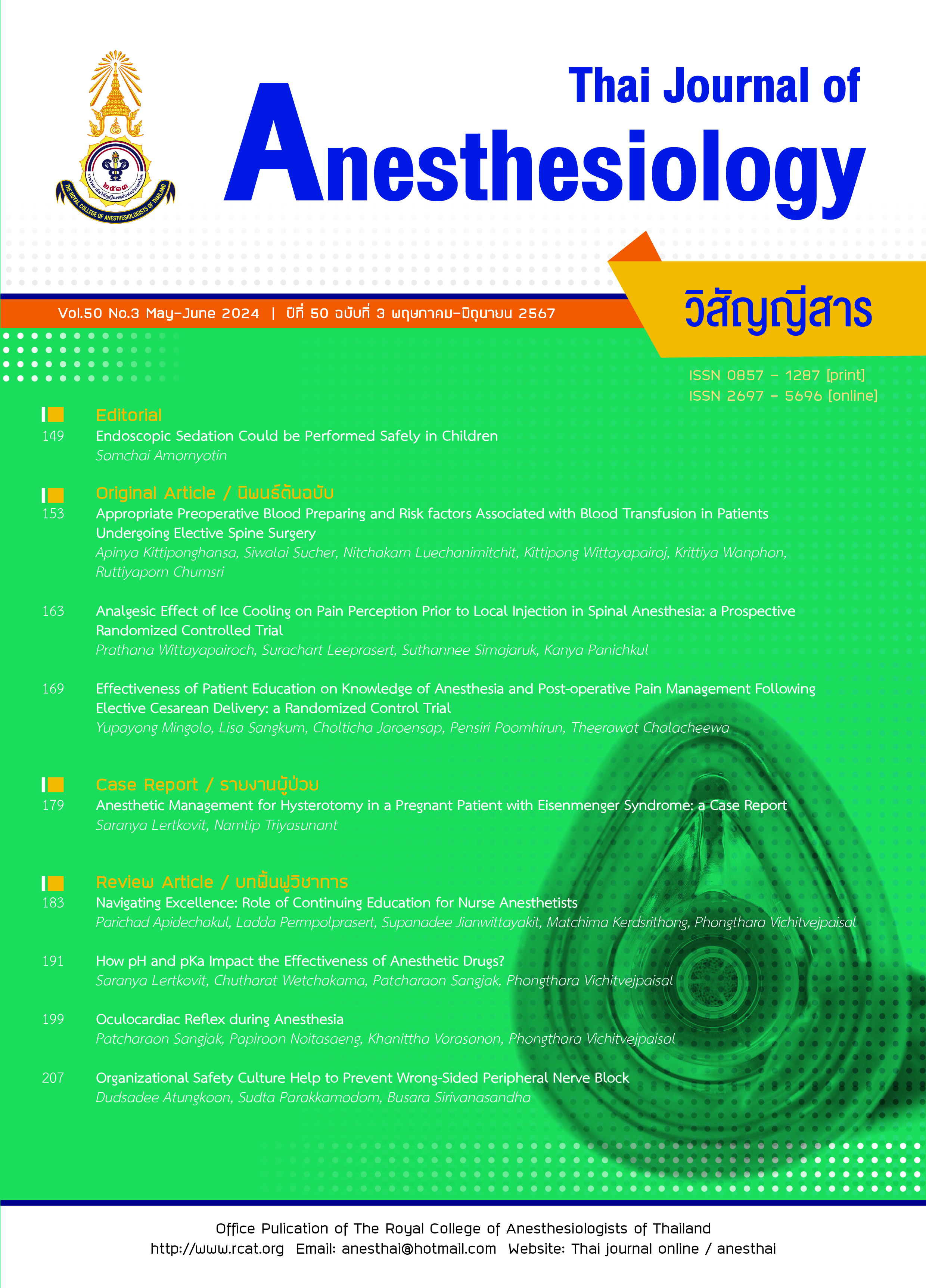How pH and pKa Impact the Effectiveness of Anesthetic Drugs?
Main Article Content
Abstract
By and large, drugs exhibit weak acid or base properties that result in an alkaline or acidic solution when dissolved. The degree of ionization in an aqueous solution can be determined by the pKa, which is unique to each drug. The ionization results in two forms: ionized (IF) and non-ionized (NIF). The IF is water-soluble, while the NIF is fat-soluble. The process is reversible and modifiable based on pH and temperature. When pH equals pKa, the IF and NIF are present in equal proportions, as determined by the Henderson-Hasselbalch equation. For weak acids, the proportion of IF is directly related to pH and the proportion of NIF is inversely related. For weak bases, the opposite is true. Many drugs used in anesthesia are weak bases, such as local anesthetics and opioids. Acidosis reduces the proportion of NIF, slowing down the drug’s efficacy as only the NIF can pass through the cell membrane. In clinical practice, local anesthetic can be injected around an abscess for incision and drainage. However, its efficacy may decrease if the surrounding tissues are acidic. To solve this problem, the physician may increase the alkalinity of the local anesthetic solution with sodium carbonate or administer antibiotics prior to the surgical procedure to enhance the drug’s effect.
Article Details

This work is licensed under a Creative Commons Attribution-NonCommercial-NoDerivatives 4.0 International License.
References
Shotelersuk V, Tongsima S, Pithukpakorn M, Eu-Ahsunthornwattana J, Mahasirimongkol S. Precision medicine in Thailand. Am J Med Genet C Semin Med Genet. 2019;181:245-53.
Urso R, Blardi P, Giorgi P. A short introduction to pharmacokinetics. Eur Rev Med Pharmacol Sci. 2002;6:33-44.
Becker DE, Reed KL. Local anesthetics: review of pharmacological considerations. Anesth Prog. 2012;59:90-102.
Michel-Levy JM. Pharmacokinetics and pharmacodynamics of local anesthetics. In: Whizar-Lugo VM, Hernández-Cortez E, eds. Topics in local anesthetics. Rijeka: IntechOpen; 2020. Available from: http://dx.doi.org/10.5772/intechopen.91700.
Giovannitti JA Jr, Rosenberg MB, Phero JC. Pharmacology of local anesthetics used in oral surgery. Oral Maxillofac Surg Clin North Am. 2013;25:453-65.
Taylor A, McLeod G. Basic pharmacology of local anaesthetics. BJA Educ. 2020;20:34-41.
Iqbal J, Hussain MM. Intestinal lipid absorption. Am J Physiol Endocrinol Metab. 2009;296:E1183-94.
Hills AG. pH and the Henderson-Hasselbalch equation. Am J Med. 1973;55:131-3.
Gilbert-Kawai ET, Wittenberg MD. Essential equations for anaesthesia key clinical concepts for the FRCA and EDA. Cambridge: Cambridge University Press. 2014.
Ferry RM. Lawrence Joseph Henderson. Science. 1942;95:316-8.
Warburg E. [Karl Albert HASSELBALCH, 1 November 1874-19 September 1962]. Ugeskr Laeger. 1962;124:1550.
Pope RLE, Brown AM. A primer on tissue pH and local anesthetic potency. Adv Physiol Educ. 2020;44:305-8.
Goodchild JH, Donaldson M. Comparing the pH change of local anesthetic solutions using two chairside buffering techniques. Compend Contin Educ Dent. 2016;37:e6-12.
Lambert DH. Clinical value of adding sodium bicarbonate to local anesthetics. Reg Anesth Pain Med. 2002;27:328-9.
Sinnott CJ, Garfield JM, Thalhammer JG, Strichartz GR. Addition of sodium bicarbonate to lidocaine decreases the duration of peripheral nerve block in the rat. Anesthesiology. 2000;93:1045-52.
Bucklin B, Santos A. Local anesthetics and opioids. In: Chestnut DH, ed. Chestnut’s obstetric anesthesia:
principles and practice. 6th ed. Philadelphia: Elsevier; 2020.


